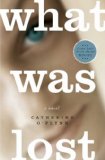Summary | Excerpt | Reading Guide | Reviews | Beyond the Book | Read-Alikes | Genres & Themes | Author Bio

A Novel
by Catherine O'FlynnThis article relates to What Was Lost
A shopping mall is defined as a collection of shops usually in one main building
or close series of buildings. It would seem that shopping malls date back to at
least the 10th century when it is said that
Isfahan's Grand Bazaar in Iran was founded (the current buildings date to
the 17th century).
The Grand Bazaar in Istanbul, Turkey was built in the 15th century and is
still one of the biggest covered markets in the world.
In the Western world, modern-day shopping malls trace their roots to the
mid-19th Century covered rows of shops known as arcades, such as the
Royal Opera Arcade (Britain's oldest built in 1818) which was closely
followed by others such as the more famous
Burlington Arcade
which opened in London in 1819. Other notable early arcades include the
Providence Arcade, Rhode Island (1828) and the
Galleria Vittorio Emanuele II in Milan, Italy (1860s).
In the USA, a fair number of shopping centers were built during the first half
of the 20th century, but it wasn't until the 1950s that the first fully enclosed
shopping mall appeared. Shoppers could park, shop, and eat in one inside
location in perceived safety. In the UK, there are many in-town shopping
centers, usually built in place of the older shopping districts, but in the USA,
in-town shopping has given way to the perceived convenience of driving to out of
town shopping areas.
However, as O'Flynn implies in her book, it is questionable whether shopping
malls are safer and it is certain that they do not provide the one-on-one
shopping experience that neighborhood shops offer. What at first seemed like a
more convenient shopping option has developed into a larger social force: the
overwhelming popularity of the shopping mall has re-oriented communities around large, impersonal shopping experiences that impact the fabric of communities once tied to local, personal shopping experiences.
Filed under Cultural Curiosities
![]() This article relates to What Was Lost.
It first ran in the July 11, 2008
issue of BookBrowse Recommends.
This article relates to What Was Lost.
It first ran in the July 11, 2008
issue of BookBrowse Recommends.
The fact of knowing how to read is nothing, the whole point is knowing what to read.
Click Here to find out who said this, as well as discovering other famous literary quotes!
Your guide toexceptional books
BookBrowse seeks out and recommends the best in contemporary fiction and nonfiction—books that not only engage and entertain but also deepen our understanding of ourselves and the world around us.